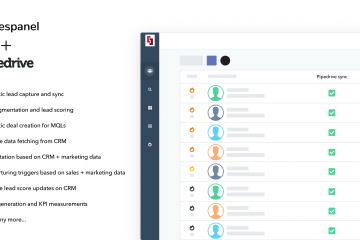How To Implement IoT Into Your Data Management Strategy
From tracking energy costs in buildings to managing production lines, there are so many ways your business can benefit from the Internet of Things (IoT). But implementing it into your existing data-management strategy is where things can get complicated. Perhaps you don’t know where to start.
You don’t have to worry. This article will guide you on implementing IoT into your data management strategy. You’ll learn straightforward steps and tips to implement quickly and easily. Keep reading to learn more.

1. Identify What You Need For And How It Will Benefit Your Business
Implementing an Internet of Things (IoT) strategy into your data management processes is a great way to add extra value and insight to your business. Knowing what you need the IoT for helps you determine which device may be suitable and how suited it is to its purpose.
For example, suppose your goal is to monitor operations in a remote location. Select devices equipped with proper connectivity and function seamlessly in a network environment.
Take advantage of the right device to help you track performance metrics efficiently and utilize other services, such as automated control systems. Once you’ve identified what you need from the IoT, you can set up its implementation.
2. Ensure That You Have The Necessary Network Connectivity
The next step, ensure your data management processes have access to the necessary network connectivity. This includes ensuring your server has a reliable connection and can handle the data load from the IoT devices.
You’ll also need a secure network to protect your data from threats. This can include firewalls, antivirus software, and encryption technology. One protocol you can look at today is MQTT. MQTT stands for Message Queuing Telemetry Transport and is a communication protocol in IoT that allows the exchange of messages between devices connected over a network. MQTT uses commands like MQTT publish, subscribe, and connect to send and receive data.
MQTT follows a publish-subscribe system, meaning each device can send and receive notifications to other devices. An MQTT broker acts as a go-between and is responsible for routing the data back and forth between all connected clients.
Using MQTT, devices can send messages with different “quality of service” levels. These levels range from 0 to 2 and allow clients to determine the reliability of their sent or received message, affecting the time it takes for an action to occur. At level 3, the most reliable message delivery, the system guarantees that all receiving clients can get all the data sent from the publishing client.
MQTT publish works using the MQTT broker, which ensures an independent network connection between clients, enabling them to communicate without relying on any single publisher or node. That way, everything is preserved in transmission, no matter how many steps it might take for your data to reach its destination across the network!
3. Set Up Connectivity To The Right Platform
Connecting your data management strategy to the right platform is essential in implementing IoT. This connection allows data sharing from one system to others securely and seamlessly. Without it, organizations face countless issues ranging from complexity, cost, and lack of control over their data and its quality. A reliable platform allows organizations to benefit from increased scalability, real-time insights, and enhanced collaboration for a better user experience.
Additionally, connecting your data strategy to the right platform gives your business access to reliable sources of information you can use for decision-making. Furthermore, these solutions’ value grows as more devices join IoT, making connectivity a crucial step in creating an effective IoT implementation plan.
4. Assign Roles For Data Collection And Analysis
Once you’ve connected your device to the right platform, it’s time to assign data collection and analysis roles. This step is crucial when implementing a data management strategy. Without clearly defined roles and responsibilities, ensuring that everyone involved knows precisely what they need to do is challenging, leading to confusion or wasted resources.
With dedicated roles, setting well-defined responsibilities and assigning tasks based on specific skills or strengths become a more straightforward process. Furthermore, having predetermined functions ensures transparency throughout the entire process so everyone can see who’s accountable for which tasks at any given time.
This structure allows teams to work more efficiently and provides valuable insight into potential bottlenecks that can stall progress. In short, assigning data collection and analysis roles is essential for orchestrating an effective data management strategy.
5. Analyze Data To Generate Insights
Analyzing data is critical for any organization trying to incorporate IoT into its management strategy. Understanding the data collected through your sensors gives you the power to make informed decisions that benefit your business regarding operational efficiency or improving customer service. It also gives you a more accurate picture of the process, including product development, inventory tracking, or logistics.
These insights help you make the most of this technology and find innovative approaches to compete with your rivals. With a clear insight into what’s happening in and around your business, you become better equipped to identify opportunities and capitalize on them.
Analyzing data gives companies far more control and leads to success in deploying IoT devices.
6. Review Your Data Management Strategy Regularly
Regularly reviewing your data management strategy is a crucial step. These reviews ensure the successful implementation of IoT into your data management plan since technology is constantly evolving. With this constant evolution comes numerous security risks.
Remember that data storage, processing, and analytics demands continue to grow rapidly. As such, frequent data management strategy reviews ensure you address security and privacy accordingly.
In addition, you must ensure that existing infrastructure can handle an increased volume of information related to IoT and any performance issues that may result from implementation. Regular reviews of your data management plan allow you to stay ahead of these challenges and better serve end users, protecting them from potential risks or vulnerabilities.
What Are The Benefits Of IoT For Data Management?
Now that you know the steps in successfully implementing IoT into your data management strategy, it’s essential to understand its benefits. Here are some critical advantages of IoT for data management:
Automation And Intelligence
One of the key benefits of IoT is its ability to automate data collection, analysis, and reporting. This automated process increases the speed and accuracy of data-driven decisions, allowing businesses to make better strategic choices based on real-time insights into their operations.
Furthermore, automating routine tasks, such as inventory tracking or asset management, saves companies time and resources that they usually spend on manual data entry and analysis.
Increased Efficiency And Productivity
IoT enables organizations to improve efficiency and productivity, especially when collecting and analyzing real-time data. A comprehensive view of your operations helps you identify any bottlenecks or areas that need improvement quickly. This allows you to make more informed decisions better aligned with your organizational objectives.
Improved Security
Security is a crucial concern for any organization that deploys IoT devices. Organizations can minimize the risk of malicious actors accessing their networks or stealing sensitive information by implementing the proper data management measures and protocols. This helps protect both the company and its customers from potential cyber-attacks.
Enhanced Decision-Making
Another integral benefit of IoT for data management is its ability to enhance decision-making. Collecting and analyzing comprehensive data help businesses gain more significant insights into their operations and customer preferences. A better understanding of the data collected through your sensors gives you the power to make informed decisions that benefit your business regarding operational efficiency or customer satisfaction.
Better Business Image
Your business image is crucial for gaining customer loyalty and trust. With IoT, companies can demonstrate their commitment to data security and efficient operations and showcase their technical capabilities. This helps businesses stand out from their competitors in a highly competitive market hence improving sales.
Reduces Operational Costs
While the initial cost of deploying IoT sensors might seem like a burden, the long-term cost savings are substantial. With automated data collection, analysis, and reporting processes, businesses can reduce their operational costs significantly while eliminating any need for manual intervention. This allows companies to optimize their operations in terms of cost and efficiency.
Are There Any Drawbacks?
While the benefits of IoT for data management are clear, it’s not without its drawbacks. For instance, deploying and managing IoT sensors requires considerable resources from an organization in terms of cost and personnel. This means that companies need to have the necessary budget and personnel to manage their IoT network properly.
Additionally, due to the sheer amount of data that IoT generates, businesses must ensure they have an effective strategy to store, analyze and draw insights from the collected data. Organizations risk overwhelming their systems with too much data without the right processes and tools.
Conclusion
The Internet of Things (IoT) offers a wealth of benefits for data management, from increased efficiency and productivity to better security and enhanced decision-making. Ensure successful IoT implementation into your data management plan with the steps in this blog post, and create a secure user environment while gaining valuable insights into business operations.
Connect your IoT devices with the right platform, assign roles for data collection and analysis, and analyze data to generate insights. These steps help you overcome the challenges in IoT. Finally, regularly reviewing your data management strategy is essential so you don’t compromise security and performance. Doing all this ensures the successful integration of IoT into your data management plan.
Sell more, understand your customers’ journey for free!
Sales and Marketing teams spend millions of dollars to bring visitors to your website. But do you track your customer’s journey? Do you know who buys and why?
Around 8% of your website traffic will sign up on your lead forms. What happens to the other 92% of your traffic? Can you identify your visiting accounts? Can you engage and retarget your qualified visitors even if they are not identified?


